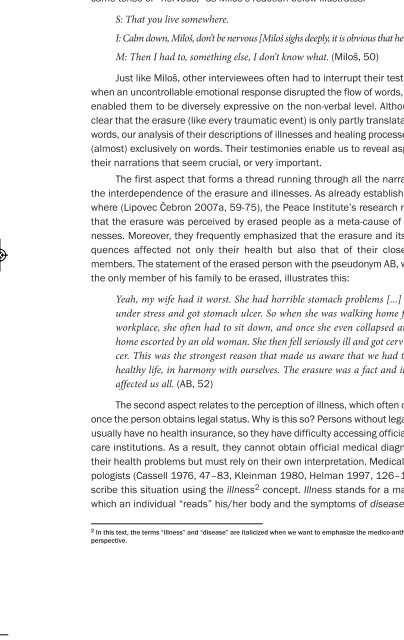The Scars of the Erasure_web
The Scars of the Erasure_web
The Scars of the Erasure_web
- No tags were found...
Create successful ePaper yourself
Turn your PDF publications into a flip-book with our unique Google optimized e-Paper software.
<strong>Erasure</strong>_4a 10.1.11 20:29 Page 154154 THE SCARS OF THE ERASUREis that some erased people tried to suppress <strong>the</strong>ir unpleasant experiences withvarying degrees <strong>of</strong> success, so re-living <strong>the</strong>se can cause trauma. For example,one erased person had to take medicine for chest and stomach pain in order tobe able to continue with <strong>the</strong> interview. Some could not hold back tears or becametense or “nervous,” as Miloš’s reaction below illustrates:S: That you live somewhere.I: Calm down, Miloš, don’t be nervous [Miloš sighs deeply, it is obvious that he is upset].M: <strong>The</strong>n I had to, something else, I don’t know what. (Miloš, 50)Just like Miloš, o<strong>the</strong>r interviewees <strong>of</strong>ten had to interrupt <strong>the</strong>ir testimonieswhen an uncontrollable emotional response disrupted <strong>the</strong> flow <strong>of</strong> words, but thisenabled <strong>the</strong>m to be diversely expressive on <strong>the</strong> non-verbal level. Although it isclear that <strong>the</strong> erasure (like every traumatic event) is only partly translatable intowords, our analysis <strong>of</strong> <strong>the</strong>ir descriptions <strong>of</strong> illnesses and healing processes relies(almost) exclusively on words. <strong>The</strong>ir testimonies enable us to reveal aspects <strong>of</strong><strong>the</strong>ir narrations that seem crucial, or very important.<strong>The</strong> first aspect that forms a thread running through all <strong>the</strong> narrations is<strong>the</strong> interdependence <strong>of</strong> <strong>the</strong> erasure and illnesses. As already established elsewhere(Lipovec Čebron 2007a, 59-75), <strong>the</strong> Peace Institute’s research revealedthat <strong>the</strong> erasure was perceived by erased people as a meta-cause <strong>of</strong> <strong>the</strong>ir illnesses.Moreover, <strong>the</strong>y frequently emphasized that <strong>the</strong> erasure and its consequencesaffected not only <strong>the</strong>ir health but also that <strong>of</strong> <strong>the</strong>ir close familymembers. <strong>The</strong> statement <strong>of</strong> <strong>the</strong> erased person with <strong>the</strong> pseudonym AB, who was<strong>the</strong> only member <strong>of</strong> his family to be erased, illustrates this:Yeah, my wife had it worst. She had horrible stomach problems [...] She wasunder stress and got stomach ulcer. So when she was walking home from herworkplace, she <strong>of</strong>ten had to sit down, and once she even collapsed and camehome escorted by an old woman. She <strong>the</strong>n fell seriously ill and got cervical cancer.This was <strong>the</strong> strongest reason that made us aware that we had to lead ahealthy life, in harmony with ourselves. <strong>The</strong> erasure was a fact and it heavilyaffected us all. (AB, 52)<strong>The</strong> second aspect relates to <strong>the</strong> perception <strong>of</strong> illness, which <strong>of</strong>ten changesonce <strong>the</strong> person obtains legal status. Why is this so? Persons without legal statususually have no health insurance, so <strong>the</strong>y have difficulty accessing <strong>of</strong>ficial healthcare institutions. As a result, <strong>the</strong>y cannot obtain <strong>of</strong>ficial medical diagnosis for<strong>the</strong>ir health problems but must rely on <strong>the</strong>ir own interpretation. Medical anthropologists(Cassell 1976, 47–83, Kleinman 1980, Helman 1997, 126–153) describethis situation using <strong>the</strong> illness 2 concept. Illness stands for a manner inwhich an individual “reads” his/her body and <strong>the</strong> symptoms <strong>of</strong> disease. Illness2 In this text, <strong>the</strong> terms “illness” and “disease” are italicized when we want to emphasize <strong>the</strong> medico-anthropologicalperspective.


